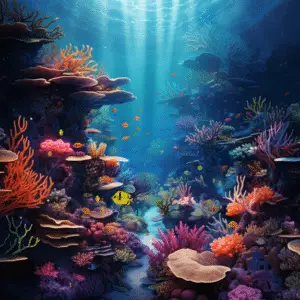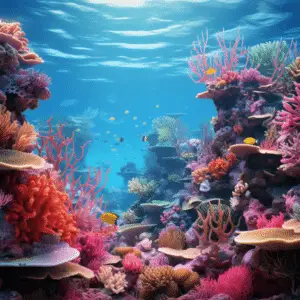Vibrant coral reefs, a mix of vibrant colors and intricate ecosystems, are vital for our planet’s health. Not just beautiful to look at, they are homes to a variety of marine species. Exploring the importance and beauty of these coral reefs reveals awe-inspiring sights and why we need to preserve them.
Divers have a unique opportunity to witness the brilliance of nature in dive sites known for their coral reefs. Australia’s Great Barrier Reef is one example. It’s a UNESCO World Heritage Site and over 2,300 kilometers long, with lots of corals and marine life. The Maldives and the Tubbataha Reefs Natural Park in the Philippines are also known for their coral gardens and colorful fish.
We can make the experience of diving in these sites better by:
- practicing responsible diving, refraining from touching or damaging corals and avoiding excessive use of fins which can damage their growth.
- participating in eco-tourism initiatives to help preserve these natural wonders for future generations.
By understanding our connection with nature, we can appreciate the significance of vibrant coral reefs. They also protect coastlines from erosion and support local economies through tourism. By being sustainable, we can contribute to the preservation of these fragile ecosystems while enjoying their captivating beauty.
Great Barrier Reef: Highlighting the famous dive spots and the diversity of marine life
The Great Barrier Reef is a must-visit for avid divers and snorkelers. It’s renowned for its iconic dive spots and incredible marine life diversity.
The Ribbon Reefs boast vibrant coral gardens and stunning drop-offs. The Cod Hole lets divers encounter massive potato cods up close. Osprey Reef offers experienced divers adrenaline-pumping adventures with breathtaking scenery.
The SS Yongala shipwreck is an iconic destination for marine life-lovers. Sea turtles, sharks, and giant groupers can be spotted here. Agincourt Reefs is perfect for all skill levels, with shallow coral gardens and drift dives.
The reef boasts over 1,500 species of fish and 400 types of hard corals, making it one of the most biodiverse regions. NASA astronaut Peggy Whitson conducted research on coral bleaching during her visit, highlighting its global importance.
The Great Barrier Reef is truly captivating and vital to our planet’s ecosystem. Its dive spots, marine life, and research efforts make it a must-visit.
Raja Ampat, Indonesia: Discussing the rich marine biodiversity and conservation efforts
Raja Ampat in Indonesia is renowned for its amazing marine life and conservation efforts. You can explore the coral reefs and witness the beauty of the underwater world, with its vivid colors and intricate details.
This destination stands out due to its commitment to conservation. Local groups and organizations work hard to protect the delicate ecosystem. They enforce sustainable fishing, create marine protected areas, and promote eco-tourism.
Divers will find many unique experiences here, like swimming with majestic manta rays or admiring the schools of vibrant fish. Dive sites cater to both beginners and experienced divers, making it a haven for underwater enthusiasts.
Our pro tip: join conservation-focused dive operators to make the most of your Raja Ampat adventure. They prioritize responsible tourism practices and contribute to preserving this precious underwater paradise.
So come and explore Raja Ampat yourself, and be inspired by the dedication towards protecting these fragile ecosystems.
Red Sea, Egypt: Exploring the incredible coral reefs and historical sites
Egypt is home to the Red Sea – renowned for its entrancing coral reefs and historic sites. Divers flock to the area to experience the glorious underwater world below the surface. The reefs are bursting with a kaleidoscope of marine life – a captivating presentation of Mother Nature’s beauty.
The Red Sea is a special place – boasting crystal-clear waters and an array of ecosystems. No wonder it’s one of the world’s top dive destinations! Plus, the area is full of ancient shipwrecks and archaeological treasures – adding a thrilling element to dives.
If you’re planning a trip to explore the Red Sea’s fabulous coral reefs and historical sites, it’s best to take a guided tour with experienced dive operators. This way, you’ll be given priceless insights on the best spots and have a safe, unforgettable experience.
Pro Tip: Don’t forget to bring an underwater camera to document the vivid colors and intriguing sea creatures you’ll come across during your dives in this incredible destination.
Maldives: Showcasing the stunning coral formations and unique marine species
The Maldives: a diving destination that boasts stunning coral formations and unique marine species! There, witness vibrant angelfish and elegant sea turtles darting around the corals. And, come across majestic manta rays and gentle whale sharks. Plus, explore underwater caves and channels for an added layer of excitement. Passionate about marine life? Put the Maldives on your bucket list! Start planning your dream diving adventure now!
Baja California, Mexico: Describing the vibrant reefs and encounters with marine mammals
Baja California, Mexico offers a remarkable experience! Coral reefs and marine mammals are captivating. An array of colourful corals and diverse underwater life make it attractive to divers from around the world.
The waters of Baja California are full of marine species. Divers will find themselves surrounded by vibrant coral formations in a kaleidoscope of colours. These provide habitats for fish, crustaceans, and other creatures.
Baja California also offers thrilling encounters with marine mammals. Dolphins, sea lions, and even whales can be spotted during migrations. These create unforgettable memories and leave divers in awe!
Moreover, National Parks and protected areas maintain the reefs and their inhabitants. This helps to preserve the extraordinary ecosystems.
The Ocean Foundation state that Baja California is home to over 600 species of fish. This makes it one of the most biodiverse regions in the world.
Exploring Baja California’s underwater world is an adventure! As you dive into its depths, be prepared to be immersed in a realm of wonder, beauty, and marine life.

Conclusion: Encouraging readers to explore these dive destinations for their vibrant coral reefs.
Dive into a vibrant world. Different dive sites with coral reefs abound. The Great Barrier Reef in Australia and Raja Ampat in Indonesia are must-visit locations. They offer breathtaking beauty and a wealth of marine life.
The Great Barrier Reef is well known for its rich biodiversity and colorful coral. Turquoise waters, teeming with tropical fish, turtles, and dolphins, make it a paradise for divers and snorkelers.
Raja Ampat is another spot for vibrant coral reefs. Off the coast of West Papua in Indonesia lies a kaleidoscope of colors. Unique marine creatures inhabit its pristine coral gardens.
Palau, a Micronesian island nation, is a lesser-known gem. Its crystal clear waters house manta rays and reef sharks. A wonderful underwater world awaits discovery.
Pro Tip: Be mindful when exploring dive sites. Don’t touch or damage coral reefs. Leave only bubbles and take only memories to protect these fragile ecosystems.
Frequently Asked Questions
FAQs about Dive Destinations Known for Vibrant Coral Reefs:
1. Which dive destinations are known for their vibrant coral reefs?
Popular dive destinations known for their vibrant coral reefs include the Maldives, Great Barrier Reef in Australia, Red Sea in Egypt, Raja Ampat in Indonesia, Palau in Micronesia, and Fiji.
2. What makes these dive destinations ideal for exploring vibrant coral reefs?
These dive destinations offer warm waters, abundant marine life, and diverse coral ecosystems. They are protected areas with strict conservation measures in place, ensuring the health and vibrancy of their coral reefs.
3. Are these dive destinations suitable for all diving levels?
Yes, these destinations cater to divers of all levels, from beginners to experienced divers. They offer a range of dive sites, including shallow reefs for novices and deeper, more challenging sites for advanced divers.
4. Can solo divers join diving trips to these destinations?
Absolutely! Many dive operators organize trips for solo divers or pair them up with other like-minded diving enthusiasts. Group dives and guided tours are also common options, ensuring everyone can enjoy these vibrant coral reefs.
5. When is the best time to visit these dive destinations?
The best time to visit these dive destinations varies. The Maldives and Fiji have good diving conditions year-round, while the Great Barrier Reef and Red Sea have optimal periods during specific months. It is advisable to check each destination’s diving season and weather patterns for the most suitable time to visit.
6. Are there any special conservation practices visitors should follow in these dive destinations?
Yes, it is essential to practice responsible diving and follow any conservation guidelines provided by dive operators or local authorities. Avoid touching or damaging the coral reefs, never feed marine life, and adhere to safe diving practices to minimize environmental impact and preserve the health of these vibrant ecosystems.

